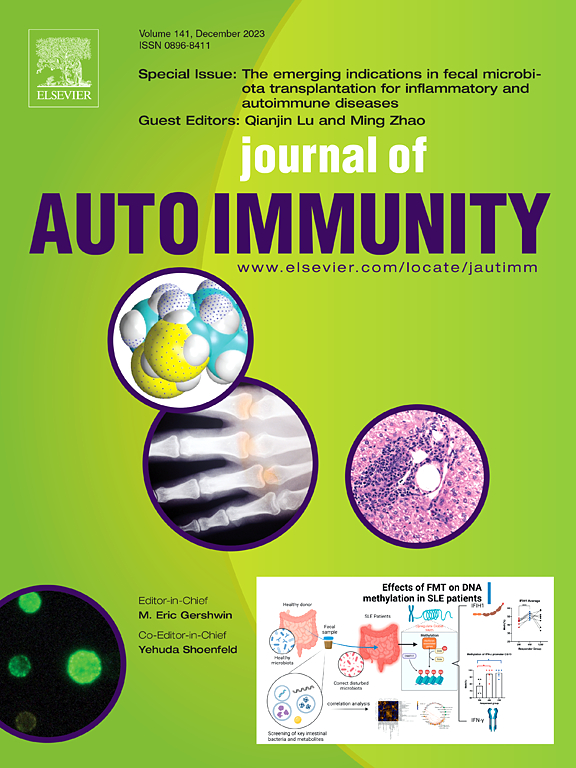Treg fitness signatures as a biomarker for disease activity in Juvenile Idiopathic Arthritis
IF 7
1区 医学
Q1 IMMUNOLOGY
引用次数: 0
Abstract
Juvenile Idiopathic Arthritis (JIA) is an autoimmune condition characterised by flares of joint inflammation. However, no reliable biomarker exists to predict the erratic disease course. Normally, regulatory T cells (Tregs) maintain tolerance, with altered Tregs associated with autoimmunity. Treg signatures have shown promise in monitoring other conditions, therefore a Treg gene/protein signature could offer novel biomarker potential for predicting disease activity in JIA.
Machine learning on our nanoString Treg 48-gene signature on peripheral blood (PB) Tregs generated a model to distinguish active JIA (active joint count, AJC≥1) Tregs from healthy controls (HC, AUC = 0.9875 on test data). Biomarker scores from this model successfully differentiated inactive (AJC = 0) from active JIA PB Tregs. Moreover, scores correlated with clinical activity scores (cJADAS), and discriminated subclinical disease (AJC = 0, cJADAS≥0.5) from remission (cJADAS<0.5).
To investigate altered protein expression as a surrogate measure for Treg fitness in JIA, we utilised spectral flow cytometry and unbiased clustering analysis. Three Treg clusters were of interest in active JIA PB, including TIGIThighCD226highCD25low Teff-like Tregs, CD39-TNFR2-Helioshigh, and a 4-1BBlowTIGITlowID2intermediate Treg cluster predominated in inactive JIA PB (AJC = 0). The ratio of these Treg clusters correlated to cJADAS, and higher ratios could potentially predict inactive individuals that flared by 9-month follow-up.
Thus, we demonstrate altered Treg signatures and subsets as an important factor, and useful biomarker, for disease progression versus remission in JIA, revealing genes and proteins contributing to Treg fitness. Ultimately, PB Treg fitness measures could serve as routine biomarkers to guide disease and treatment management to sustain remission in JIA.
Treg适应度特征作为青少年特发性关节炎疾病活动性的生物标志物
幼年特发性关节炎(JIA)是一种以关节炎症为特征的自身免疫性疾病。然而,没有可靠的生物标志物来预测不稳定的病程。正常情况下,调节性T细胞(Tregs)维持耐受性,Tregs的改变与自身免疫有关。Treg标记在监测其他疾病方面已经显示出前景,因此Treg基因/蛋白质标记可能为预测JIA的疾病活性提供新的生物标志物潜力。利用我们在外周血(PB) Tregs上的nanoString Treg 48基因签名进行机器学习,生成了一个区分活跃JIA(活跃关节计数,AJC≥1)Tregs与健康对照(HC,测试数据AUC = 0.9875)的模型。该模型的生物标志物评分成功区分了不活跃(AJC = 0)和活跃的JIA PB Tregs。此外,评分与临床活动评分(cJADAS)相关,并将亚临床疾病(AJC = 0, cJADAS≥0.5)与缓解(cJADAS<0.5)区分开来。为了研究蛋白表达的改变作为JIA中Treg适应度的替代指标,我们使用了光谱流式细胞术和无偏聚类分析。活跃的JIA PB中有3个Treg簇,包括TIGIThighCD226highCD25low Teff-like Treg、cd39 - tnfr2 - heliohigh和4- 1blolowtigitlowid2 intermediate Treg簇(AJC = 0)。这些Treg簇的比例与cJADAS相关,较高的比例可能预示着在9个月的随访中不活跃的个体爆发。因此,我们证明了Treg特征和亚群的改变是JIA疾病进展与缓解的重要因素和有用的生物标志物,揭示了与Treg适应度有关的基因和蛋白质。最终,PB Treg适应度测量可以作为常规生物标志物来指导疾病和治疗管理,以维持JIA的缓解。
本文章由计算机程序翻译,如有差异,请以英文原文为准。
求助全文
约1分钟内获得全文
求助全文
来源期刊

Journal of autoimmunity
医学-免疫学
CiteScore
27.90
自引率
1.60%
发文量
117
审稿时长
17 days
期刊介绍:
The Journal of Autoimmunity serves as the primary publication for research on various facets of autoimmunity. These include topics such as the mechanism of self-recognition, regulation of autoimmune responses, experimental autoimmune diseases, diagnostic tests for autoantibodies, as well as the epidemiology, pathophysiology, and treatment of autoimmune diseases. While the journal covers a wide range of subjects, it emphasizes papers exploring the genetic, molecular biology, and cellular aspects of the field.
The Journal of Translational Autoimmunity, on the other hand, is a subsidiary journal of the Journal of Autoimmunity. It focuses specifically on translating scientific discoveries in autoimmunity into clinical applications and practical solutions. By highlighting research that bridges the gap between basic science and clinical practice, the Journal of Translational Autoimmunity aims to advance the understanding and treatment of autoimmune diseases.
 求助内容:
求助内容: 应助结果提醒方式:
应助结果提醒方式:


